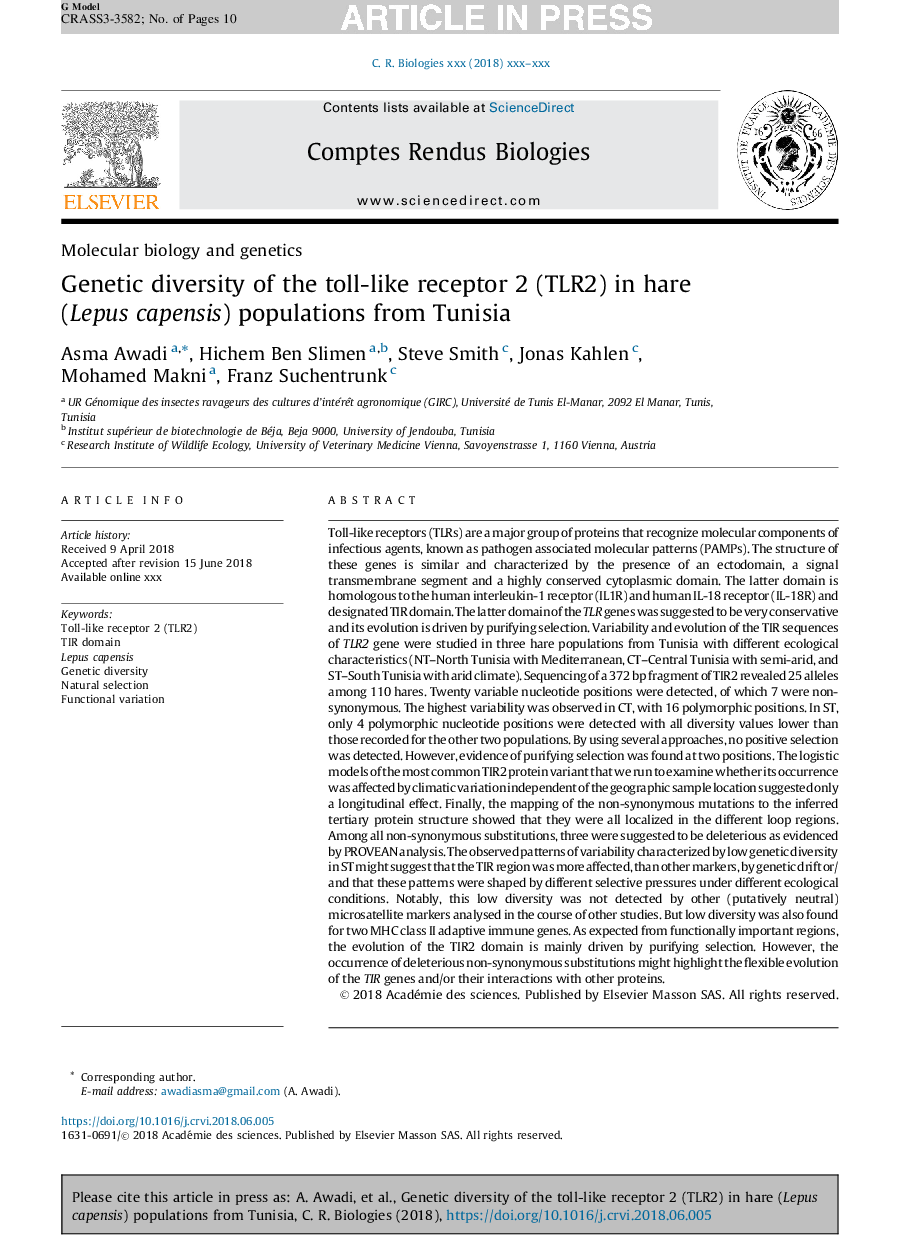| کد مقاله | کد نشریه | سال انتشار | مقاله انگلیسی | نسخه تمام متن |
|---|---|---|---|---|
| 8625317 | 1568195 | 2018 | 10 صفحه PDF | دانلود رایگان |
عنوان انگلیسی مقاله ISI
Genetic diversity of the toll-like receptor 2 (TLR2) in hare (Lepus capensis) populations from Tunisia
دانلود مقاله + سفارش ترجمه
دانلود مقاله ISI انگلیسی
رایگان برای ایرانیان
کلمات کلیدی
موضوعات مرتبط
علوم زیستی و بیوفناوری
علوم کشاورزی و بیولوژیک
علوم کشاورزی و بیولوژیک (عمومی)
پیش نمایش صفحه اول مقاله

چکیده انگلیسی
Toll-like receptors (TLRs) are a major group of proteins that recognize molecular components of infectious agents, known as pathogen associated molecular patterns (PAMPs). The structure of these genes is similar and characterized by the presence of an ectodomain, a signal transmembrane segment and a highly conserved cytoplasmic domain. The latter domain is homologous to the human interleukin-1 receptor (IL1R) and human IL-18 receptor (IL-18R) and designated TIR domain. The latter domain of the TLR genes was suggested to be very conservative and its evolution is driven by purifying selection. Variability and evolution of the TIR sequences of TLR2 gene were studied in three hare populations from Tunisia with different ecological characteristics (NT-North Tunisia with Mediterranean, CT-Central Tunisia with semi-arid, and ST-South Tunisia with arid climate). Sequencing of a 372Â bp fragment of TIR2 revealed 25 alleles among 110 hares. Twenty variable nucleotide positions were detected, of which 7 were non-synonymous. The highest variability was observed in CT, with 16 polymorphic positions. In ST, only 4 polymorphic nucleotide positions were detected with all diversity values lower than those recorded for the other two populations. By using several approaches, no positive selection was detected. However, evidence of purifying selection was found at two positions. The logistic models of the most common TIR2 protein variant that we run to examine whether its occurrence was affected by climatic variation independent of the geographic sample location suggested only a longitudinal effect. Finally, the mapping of the non-synonymous mutations to the inferred tertiary protein structure showed that they were all localized in the different loop regions. Among all non-synonymous substitutions, three were suggested to be deleterious as evidenced by PROVEAN analysis. The observed patterns of variability characterized by low genetic diversity in ST might suggest that the TIR region was more affected, than other markers, by genetic drift or/and that these patterns were shaped by different selective pressures under different ecological conditions. Notably, this low diversity was not detected by other (putatively neutral) microsatellite markers analysed in the course of other studies. But low diversity was also found for two MHC class II adaptive immune genes. As expected from functionally important regions, the evolution of the TIR2 domain is mainly driven by purifying selection. However, the occurrence of deleterious non-synonymous substitutions might highlight the flexible evolution of the TIR genes and/or their interactions with other proteins.
ناشر
Database: Elsevier - ScienceDirect (ساینس دایرکت)
Journal: Comptes Rendus Biologies - Volume 341, Issue 6, JulyâAugust 2018, Pages 315-324
Journal: Comptes Rendus Biologies - Volume 341, Issue 6, JulyâAugust 2018, Pages 315-324
نویسندگان
Asma Awadi, Hichem Ben Slimen, Steve Smith, Jonas Kahlen, Mohamed Makni, Franz Suchentrunk,